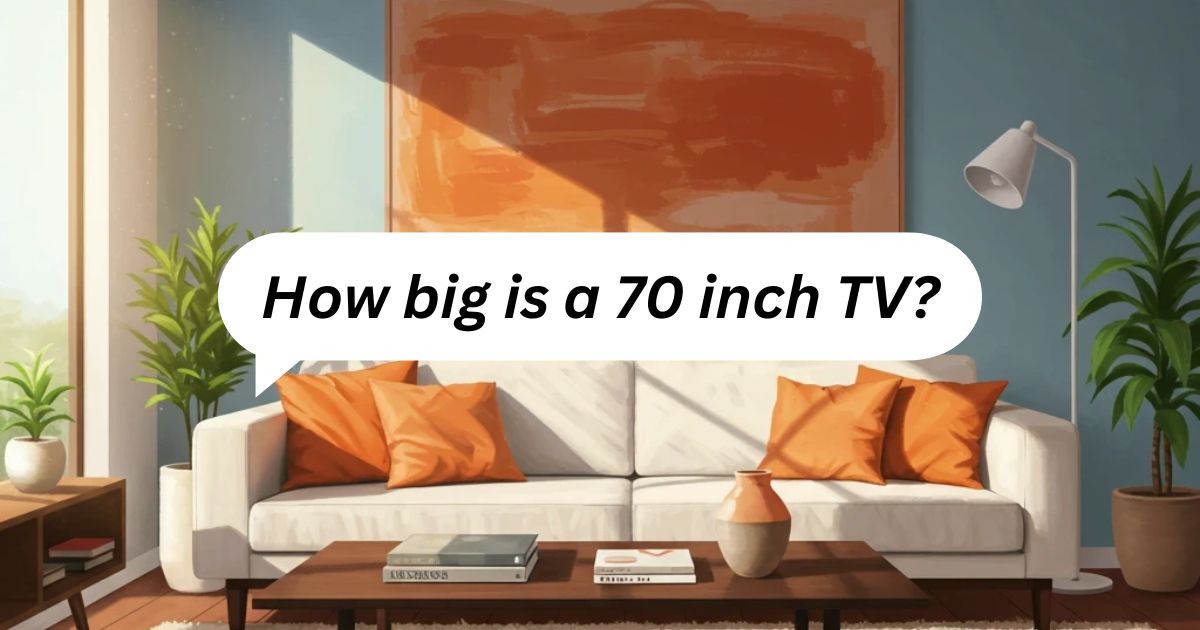When shopping for a new television, size matters significantly. The question “how big is a 70 inch TV” becomes crucial when planning your home entertainment setup.
This comprehensive guide explores the actual dimensions, viewing experience, and everything you need to know before bringing this impressive display into your home.
Real-World Size Perspective
A 70-inch TV measures exactly 70 inches diagonally from corner to corner. In practical terms, this translates to approximately 61 inches (154 cm) in width and 35 inches (89 cm) in height. Most people don’t realize that a television of this size is actually wider than many standard doorways in American homes.
Despite their commanding screen presence, modern 70-inch TV models maintain a surprisingly slim profile of just 3-4 inches (8-10 cm) in depth, thanks to advancements in LED technology.
The physical presence of a 70-inch television creates a striking focal point in any room. Imagine having a window into another world that dominates your wall space. This substantial screen size delivers an impressive viewing experience that approaches what you might find in small commercial theaters.
Comparing TV Sizes
Understanding how a 70-inch TV compares to other popular sizes helps put its dimensions into perspective. A 70-inch display offers approximately 50% more viewing area than a 55-inch TV.
While a 55-inch television provides roughly 27 sq ft of screen space, stepping up to a 70-inch model expands this to an immersive 41 sq ft of viewing area. This significant increase in screen real estate dramatically transforms your viewing experience.
Sports broadcasts capture more of the field, movies deliver more cinematic impact, and gaming becomes truly immersive. The difference isn’t subtle—it’s transformative, especially when upgrading from smaller displays that might leave you squinting to catch details from across the room.
Optimal Viewing Experience
Finding the perfect distance between your seating and a 70-inch TV ensures maximum enjoyment without eye strain. For a 4K TV of this size, experts recommend a viewing distance between 8.5 to 11.5 feet from the screen. This range allows you to appreciate the 8.3 million pixels without discerning individual dots, creating that perfect cinema-like experience at home.
Sitting too close to a screen this large can cause visual fatigue as your eyes work harder to take in the entire display. Conversely, sitting too far away diminishes the immersive quality these large screens are designed to provide.
The ideal distance creates a balanced field of view where the screen occupies enough of your vision to feel immersive without requiring excessive head movement to follow the action.
Room Requirements and Placement

Before investing in a 70-inch TV, carefully evaluate your space dimensions. These substantial displays require adequate wall space and proper furniture support, as they typically weigh between 70-100 lbs. Proper placement enhances both comfort and aesthetic integration with your living environment.
The ideal room size for a 70-inch television starts at approximately 12×12 feet or larger. Smaller spaces may create an overwhelming viewing experience that feels more like sitting in the front row of a movie theater.
Consider not just the wall where the TV will be mounted, but also the room depth to accommodate recommended viewing distances. Measure your available wall space carefully, accounting for any architectural features like windows, doorways, or fireplaces that might limit placement options.
Current Market Options
Leading manufacturers including Samsung, LG, and Sony offer 70-inch TV models ranging from $800 to $2,000. This price variation reflects differences in picture technology, smart features, and build quality. Most current models include 4K TV resolution and smart TV capabilities as standard features.
Samsung typically leads with vibrant displays featuring excellent color reproduction and user-friendly interface designs. LG offers remarkable viewing angles and intuitive operating systems, while Sony often excels in motion handling and upscaling technology for non-4K content.
When comparing models, pay attention to specific technologies like QLED, OLED, or Mini-LED that can significantly impact picture quality and justifiably increase the price point.
Setting Up Your Home Theater
Maximizing the potential of your 70-inch TV involves creating a complementary home theater environment. Consider incorporating bias lighting behind the television to reduce eye strain and enhance perceived contrast.
A quality soundbar or surround sound system significantly improves the immersive quality of your entertainment experience. Proper cable management solutions maintain a clean aesthetic while reducing visual clutter around your impressive display.
Take time to calibrate the picture quality settings for your specific lighting conditions—many televisions come with preset modes that can be further adjusted to match your preferences. Consider consulting online calibration guides specific to your model for optimal results without expensive professional calibration services.
Gaming and Alternative Uses
Beyond traditional viewing, a 70-inch TV offers exceptional versatility for various applications. Gaming enthusiasts particularly benefit from these large displays, as modern gaming consoles deliver increasingly detailed worlds that shine on expansive screens.
The immersive quality of racing games, sports simulations, and adventure titles reaches new heights when displayed at this scale. Additionally, these televisions can function as impressive computer monitors for productivity or creative work.
Their substantial screen size makes them excellent for video conferencing, presentations, or collaborative workspaces. The expansive display area of a 70-inch TV provides flexibility for multi-window viewing, allowing simultaneous content consumption or productivity applications without feeling cramped.
Size Comparison with Other Models
Within the television size spectrum, 70-inch models occupy a significant position. For context:
| TV Size | Width (approx.) | Height (approx.) | Screen Area | Comparison to 70″ |
| 60-inch | 52″ (132 cm) | 29″ (74 cm) | 30 sq ft | 27% smaller |
| 65-inch | 57″ (145 cm) | 32″ (81 cm) | 36 sq ft | 12% smaller |
| 70-inch | 61″ (154 cm) | 35″ (89 cm) | 41 sq ft | – |
| 75-inch | 65″ (165 cm) | 37″ (94 cm) | 47 sq ft | 15% larger |
| 82-inch | 72″ (183 cm) | 40″ (102 cm) | 56 sq ft | 37% larger |
| 85-inch | 74″ (188 cm) | 42″ (107 cm) | 60 sq ft | 46% larger |
| 100-inch | 87″ (221 cm) | 49″ (124 cm) | 83 sq ft | 102% larger |
Understanding these size relationships helps position the 70-inch option within the broader range of available television dimensions. The jump from 65 to 70 inches might seem small numerically, but it represents a notable increase in viewing area that can significantly enhance your experience.
Installation Considerations
Professional mounting is highly recommended for 70-inch TV installations due to their substantial weight. The process requires careful planning to ensure your wall can adequately support 150+ pounds (accounting for both the TV and mounting hardware). Always use a VESA compatible mount specifically rated for large televisions in this weight class.
If wall mounting isn’t an option, ensure your furniture is rated to support the television’s weight plus a safety margin. Television stands designed for large displays typically feature reinforced construction and lower centers of gravity to prevent tipping.
Whether wall-mounted or placed on furniture, ensure adequate ventilation around the television’s edges and vents to prevent overheating during extended use periods.
Making the Right Choice

Selecting the ideal 70-inch TV involves balancing room dimensions, viewing habits, and budget considerations. The substantial size of these displays creates a transformative viewing experience when properly integrated into appropriate spaces. Consider your typical viewing content, as sports and films particularly benefit from larger screens.
Feature priorities should align with your specific usage patterns, whether emphasizing gaming capabilities, smart functionality, or picture quality. A thoughtfully selected 70-inch TV delivers years of impressive viewing when matched to your specific environment and requirements.
Smart Features and Connectivity
Modern 70-inch TV models incorporate comprehensive smart features and connectivity options. Built-in Wi-Fi connects seamlessly to streaming services including Netflix, Prime Video, and other popular platforms. Multiple HDMI ports (typically 3-4) allow connection of gaming consoles, soundbars, and additional streaming devices without constant switching.
Advanced models offer voice control integration with popular smart home ecosystems, while built-in app stores provide access to thousands of applications beyond traditional content consumption.
These connectivity features transform a television from a simple display into a complete entertainment hub capable of streaming your favorite shows, playing music, displaying photos, and even controlling compatible smart home devices in some cases.
Picture Quality Considerations
Most current 70-inch TV models feature HDR (High Dynamic Range) support, delivering enhanced contrast with deeper blacks, brighter whites, and more vibrant colors. Premium televisions incorporate local dimming zones or advanced panel technologies that further enhance image quality, particularly in dark scenes or high-contrast content.
The substantial screen size magnifies both quality and deficiencies, making picture quality especially important in this size category. When evaluating options, pay particular attention to contrast ratios, brightness capabilities, and color accuracy. Features like refresh rates become increasingly important for sports fans and gamers who need smooth motion handling for fast-action content.
Room Lighting Impact
Environmental lighting substantially affects viewing quality on large displays. Natural light sources can create significant glare on the expansive screen surface of a 70-inch TV. Consider installing room-darkening curtains or positioning the TV to minimize reflections from windows and lighting fixtures.
Bias lighting behind the television reduces eye strain during extended viewing sessions while enhancing perceived picture quality. This simple addition creates a subtle glow behind the screen that reduces the contrast between the bright display and darker surrounding areas, making viewing more comfortable.
The relationship between room lighting and display brightness should be balanced for optimal viewing comfort across varying content types and viewing periods.
Maintenance Tips
Proper maintenance ensures optimal performance and longevity for your investment in a 70-inch TV. Always clean screens using only microfiber cloths to prevent scratches or damage to anti-glare coatings. Never apply cleaning solutions directly to the screen—instead, lightly dampen the cloth if necessary.
Regular dust removal prevents buildup that can affect both appearance and ventilation efficiency. Quarterly inspection of wall mounts or support furniture ensures continued security as settling and vibration over time can loosen connections.
Additionally, keep remote controls and accessories organized to prevent loss or damage that might impair your enjoyment of this significant entertainment investment.
Energy Efficiency
Despite their substantial size, modern 70-inch LED TVs demonstrate impressive energy efficiency. Typical models consume between 100-200 watts during operation, with Energy Star rated options offering further reduced power requirements. This efficiency results from advancements in LED backlighting technology and power management systems.
Annual operating costs remain reasonable despite the large display area, particularly when compared to older large-format technologies. Power-saving features like automatic brightness adjustment and sleep timers further enhance efficiency during daily use, keeping electricity costs manageable even with regular viewing habits.
Value Proposition
While 70-inch TV models represent a significant investment ranging from $800 to $2,000, they offer compelling value considerations for most households. These impressive displays deliver an immersive home theater experience approaching commercial venues without the recurring costs of tickets and concessions.
The versatility of modern large-screen televisions extends their value beyond simple content consumption to include gaming, computing, and smart home integration. With proper care, these displays offer extended lifespans of 7-10 years, spreading the initial investment across many years of enjoyment.
Additionally, modern connectivity features and software updates help keep these devices relevant as content delivery methods evolve.
Common Concerns Addressed
When considering a 70-inch TV purchase, several common concerns arise among potential buyers. Durability remains a primary consideration given the significant investment—fortunately, quality manufacturers provide 1-2 year warranties with options for extension. Installation complexity worries many consumers, but professional mounting services are widely available at reasonable costs relative to the television’s value.
Viewing quality concerns, particularly regarding pixel visibility at closer distances, are largely unfounded with modern 4K TV technology, which maintains excellent clarity even at recommended viewing distances.
Audio limitations inherent in slim television designs can be easily addressed through various supplementary sound solutions accommodating different spaces and budgets. Finally, concerns about technology obsolescence are mitigated by the standardization of current connectivity options and the forward-compatible nature of display technologies.
Shopping Tips

Strategic purchasing approaches maximize value when investing in a 70-inch TV. Compare models during major retail sales events like Black Friday, Super Bowl promotions, or end-of-model-year clearances for optimal pricing.
Consult professional reviews featuring detailed technical testing beyond manufacturer specifications before making final decisions. Always verify return policies considering the challenges of transporting large televisions if issues arise.
Consider extended warranties for protecting substantial investments, particularly for high-end models with advanced technologies. Evaluate bundled offerings including installation services or audio equipment, which often provide better overall value than purchasing components separately.
FAQ’s
Is 70 inches too big for most living rooms?
A 70-inch TV is ideal for rooms measuring at least 12×12 feet or larger, with adequate viewing distances of 8.5-12 feet for comfortable enjoyment.
How much do 70 inchers weigh?
Most 70-inch TV models weigh between 70-100 lbs without stands or mounting hardware, requiring proper support whether wall-mounted or furniture-placed.
Can I wall mount a 70″ TV?
Yes, with appropriate VESA compatible mount rated for the weight class (typically supporting 150+ pounds including hardware) and professional installation recommended.
How far should I sit from a 70″?
The ideal viewing distance ranges from 8.5 to 11.5 feet, with 9 feet being the sweet spot for most 4K TV content to balance immersion and comfort.
What’s bigger than 70 inches?
Larger options include 75-inch (+5″), 82-inch (+12″), 85-inch (+15″), and 100-inch (+30″) models for those seeking even more impressive displays.
Making the Final Decision
A 70-inch TV represents a transformative addition to your entertainment environment. The key to satisfaction lies in aligning this substantial display with your specific space dimensions, content preferences, and budget parameters. Careful measurement and thoughtful consideration of viewing distances ensure optimal integration into your living space.
With proper planning and installation, a 70-inch television delivers years of impressive, immersive entertainment for movies, sports, gaming, and everyday viewing experiences. The ideal selection creates perfect balance between screen size, picture quality, and room integration—transforming ordinary viewing into extraordinary experiences that you’ll enjoy daily.











